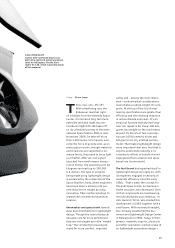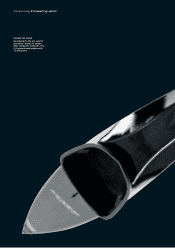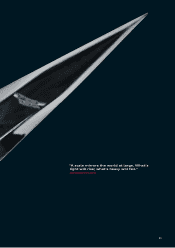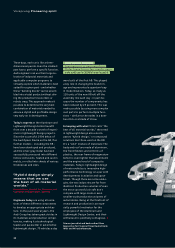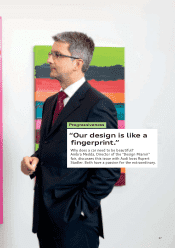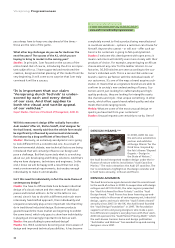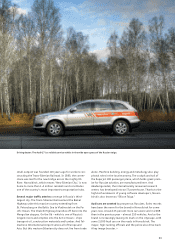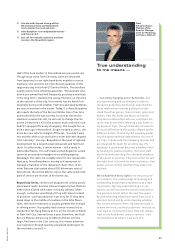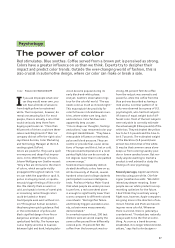Audi 2008 Annual Report Download - page 32
Download and view the complete annual report
Please find page 32 of the 2008 Audi annual report below. You can navigate through the pages in the report by either clicking on the pages listed below, or by using the keyword search tool below to find specific information within the annual report.
r. Stadler, you often speak about how design is
one of the absolute core competencies of the
Audi brand. At the same time, we are hearing
over and over again that the automobile industry is going
to have to reinvent itself in order to deal with current chal-
lenges. So is the characteristic Audi design therefore going
to change?
Rupert Stadler: There is no doubt that our society is going
through a difficult period. And the automobile industry, of
course, is also significantly impacted by these new chal-
lenges. In times of turmoil, people are even more likely to
look for orientation and reliability. Orientation is some-
thing we as a company need to be able to give our cus-
tomers. Therefore, the very best thing we can do is to
ensure that our products fulfill the same high standards
of quality in the future that have made them known and
sought after in the past. And, of course, that also includes
the design of our vehicles. Their look and feel may change –
but only in terms of evolutionary and careful improve-
ments. We want to emphasize the authenticity of our mod-
els through our own unmistakable messages, and are thus
developing into a signature brand. You could say that each
and every one of our cars is as unique as a fingerprint.
Ambra Medda: I completely agree with that approach. Of
course, a paradigm shift of sorts is underway right now,
and it would be very surprising not to see it reflected in the
design area. Good designers react to their environment.
But this doesn’t mean they immediately resort to hasty
action.
Since when has product design played such a decisive role
in sales success?
Medda: It’s hard to pinpoint exactly when. However, one
thing I know for sure is that there isn’t a company today
that can afford to sidestep the unique selling point design
has to offer. Of course, that has a lot to do with the grow-
ing importance of marketing. Anyone who wants to set
themselves apart from the competition is going to have to
articulate this. At the latest, that’s when product design
comes into play.
Stadler: That’s certainly true. Nonetheless, design domi-
nance has not suddenly become relevant in recent years.
The Audi brand, for example, is celebrating its centennial
anniversary this year. The design of our cars was already
playing a significant role in our marketing success way back
in the 1920s and 1930s. Though it primarily had to do with
the notion of “beauty,” the basic principle behind it, name-
ly wanting to have this beauty for oneself, is the same to-
day as it was then.
Would it be true to say that a new era is also always pre-
ceded by a new perception of design?
Medda: I believe so. Take the triumph of the Apple iPod,
for example. Any one of us could have gone to a store and
bought a similar MP3 player at a fraction of the cost. Even
so, most of us will buy the more expensive Apple device.
And why? Because it looks different; because it has a de-
sign that is considered contemporary. It is a product that
has come to symbolize the hip and modern face of the digi-
tal revolution. And that’s why people just have to have it.
Stadler: Anyone wanting to sell a premium product today
is going to have to be able to give his customers clever and
fresh answers to the pressing issues of the time. In other
words: Anyone who buys an Audi today will expect it to ful-
fill environmental standards; they will expect it to combine
the very best of today’s technology with comfort, safety
and driving pleasure. As far as I am concerned, any car that
ignores sustainability is not in line with the times. Anyone
wanting to grab his customer’s attention is going to have
to keep thinking outside the box, be willing to take on
something new, and put his own stamp on it. That’s the
goal of a signature brand, which is what we’re aspiring to
be at Audi.
Medda: There is no comparison between how much more
selective customers are today than they were a few years
ago. They have come to recognize good design and
good quality. They are more familiar with standards so
are also less prepared to forfeit them. Design today is no
longer a neat gimmick; design is a core component of
every product.
Stadler: We have a promise to keep to our customers: “Vor-
sprung durch Technik.” That may sound easy, but it is also
important that this claim is underscored by each and every
detail of our cars. And that applies to both the visual and
tactile appeal of our vehicles: In the premium segment,
Interview Dominik Wichmann
Photos Joel Micah Miller
M
Vorsprung Progressiveness
AMBRA MEDDA
Ambra Medda, 28, grew up in England and Italy. In 2005,
Medda founded Design Miami/, now one of the world’s
leading fairs for high-end design. In April 2008, Medda
published her first book entitled “Destination: Limited-
Edition Design,” an overview of the 60 most sought-
after design destinations in the world.
28
“What matters is that the product
also has a past. This is always
a good basis for a truly sophisticated
and creative design.”
Ambra Medda, Director of Design Miami/



